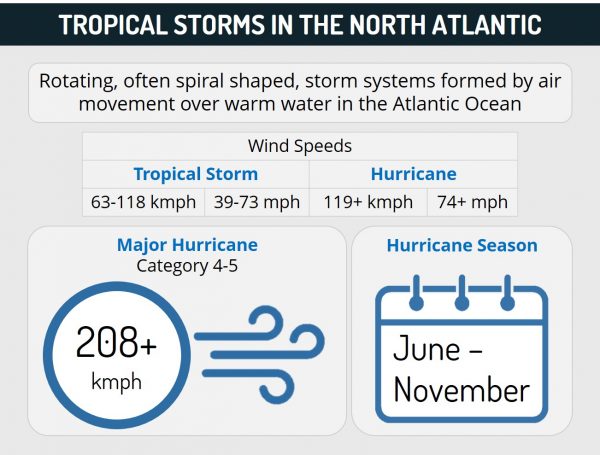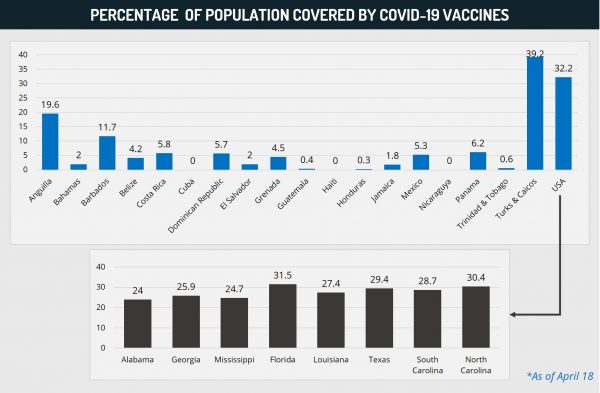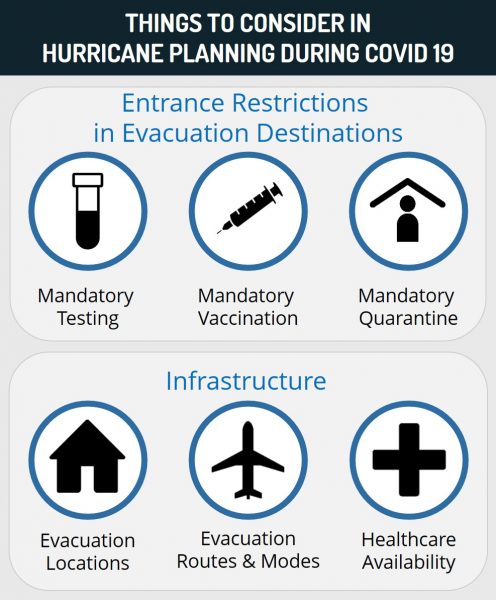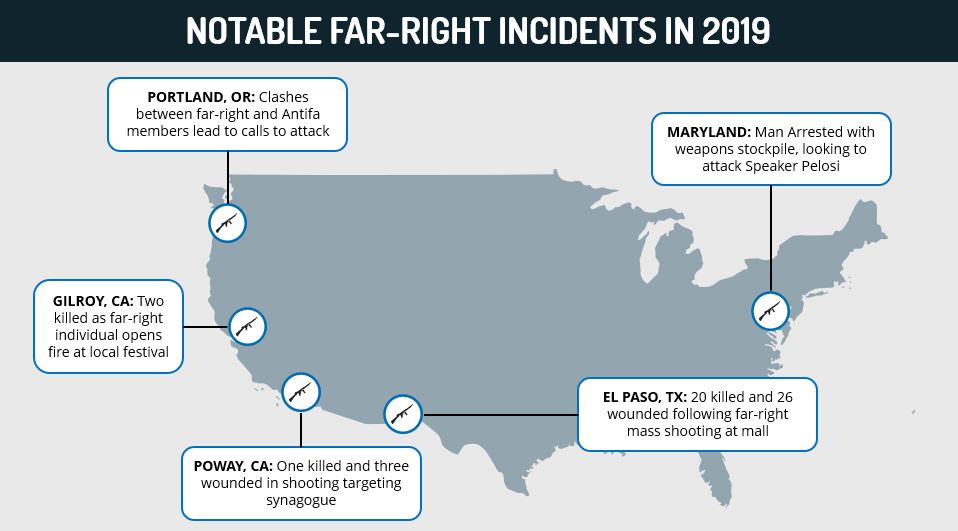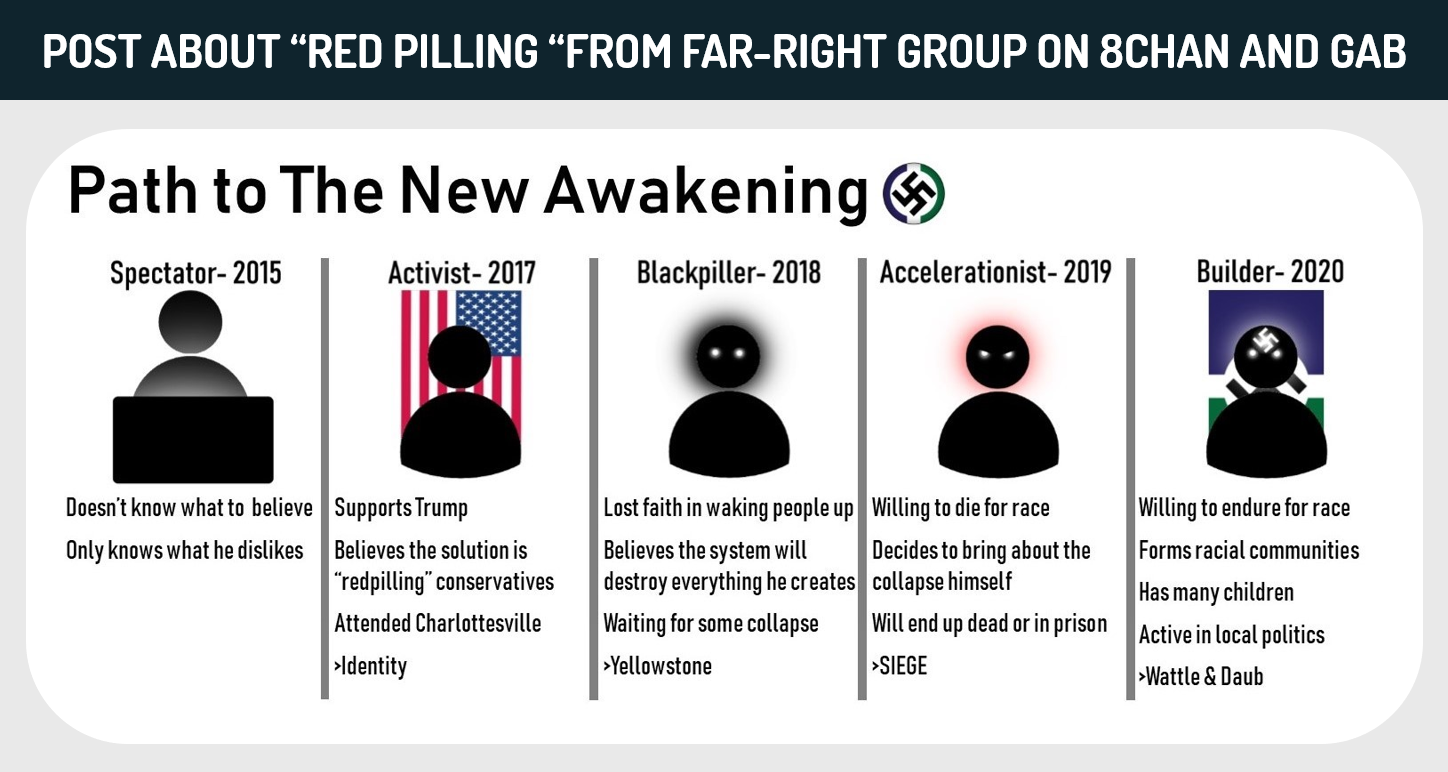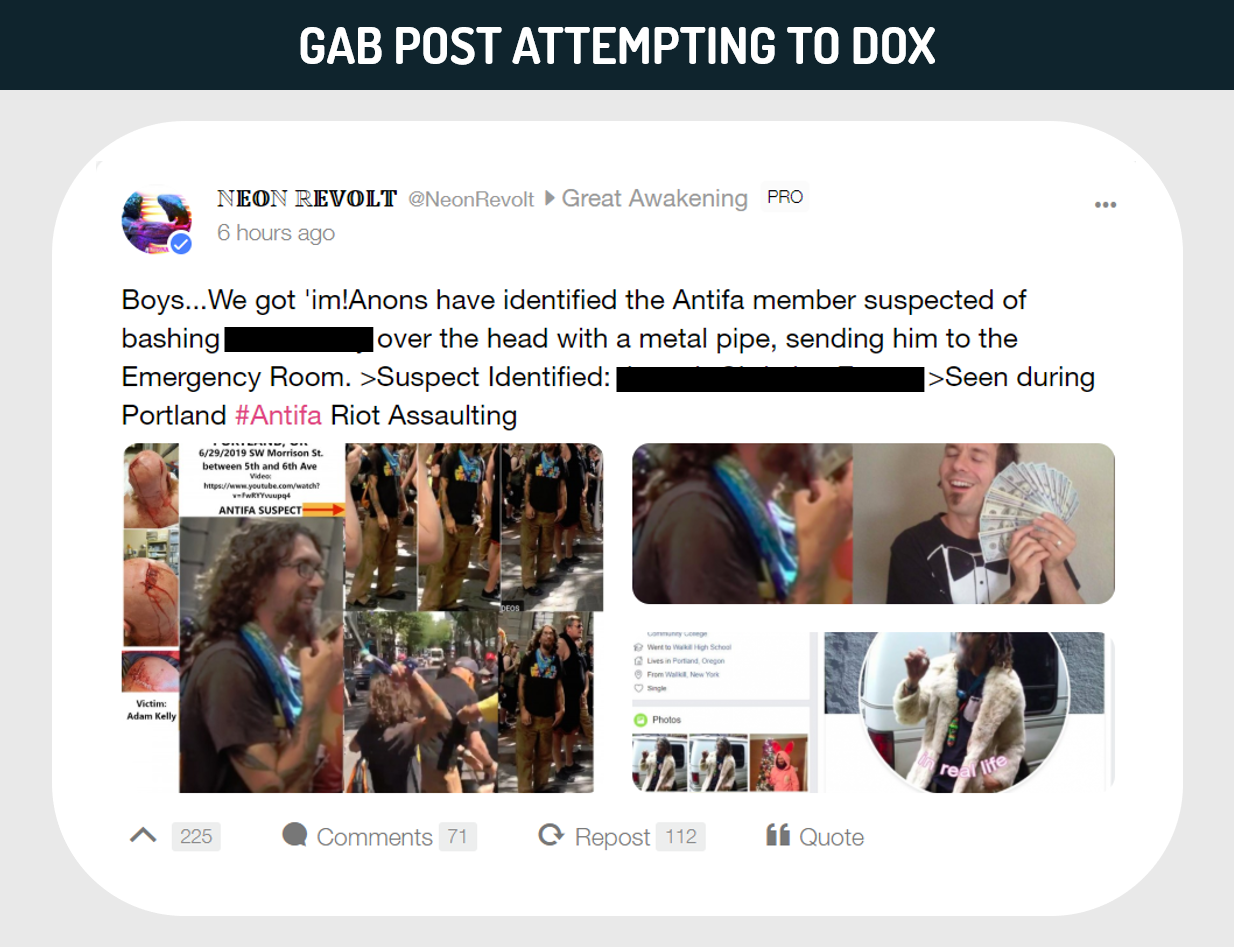Executive Summary
- The 2021 North Atlantic Hurricane Season is expected to witness at least 10 hurricanes between June and November.
- Planning for the season will be impacted by COVID-19 considerations, including restrictions on travel.
- Based on the situation in 2020, the region’s uneven COVID-19 response will be disrupted by these storms, just as vaccination campaigns are set to speed up.
- Given this, the 2021 Hurricane Season will have long-term impacts on the health, transport, and political infrastructure of Central and North America, and the Caribbean.
- Those operating or residing in the Caribbean, Central America, and North America are advised to review and update existing hurricane preparedness protocols in consideration of COVID-19 regulations.
Please be advised
North Atlantic Hurricane Season: 2020 review and 2021 forecast
- Between 2011-2020, there was an average of 17 named tropical storms, seven hurricanes, and three major hurricanes in the North Atlantic each year (17-7-3). In 2020, this ratio was 30-13-6. It was the most active hurricane season on record, with Hurricane Iota being the latest Category 5 to form in November since 1932; the fifth season in a row that a Category 5 has formed.
- Within the Caribbean, Central America, and North America, over 430 deaths were recorded and over 50 billion USD in damages were caused by widespread flooding, landslides, debris falling, and disruptions to essential utilities.
- Hurricane Laura (Cat 4) killed 77 [42 USA, 31 Haiti, 4 Dominican Rep] and caused over 14 billion USD worth of damages over nine days in August, fluctuating in strength, regaining enough power over the Gulf of Mexico to be the strongest hurricane to make landfall in Louisiana in over 150 years.
- Hurricane Delta’s wind speeds intensified from 55 kmph (35 mph) to 215 kmph (130 mph) within 24-hours, the fastest such intensification on record. The hurricane knocked out power to over 750,000 customers in the USA as it passed along the Gulf Coast.
- For 2021, as of April 18, various observers forecast between 16-18 named storms, 6-9 hurricanes, and 3-4 major hurricanes between June and November. It should be noted that at the same time in 2020, the same observers forecast similar numbers based on the decadal average, 17-7-3, while the end tally was nearly double on all counts.
2020 witnessed unprecedented modern-day impact in Central America
- Hurricanes Eta and Iota passed over Central Americas in November 2020 and were responsible for at least 270 of the roughly 430 deaths recorded across North and Central America during the 2020 Hurricane Season.
- Roughly nine billion USD worth of damage was reportedly sustained, including five billion USD to Honduras alone during Hurricane Eta.
- Landslides and flooding hit large parts of Honduras, Guatemala, El Salvador, and other countries in the region, destroying infrastructure and causing widespread homelessness.
- The US Agency for International Development (USAID) estimated that roughly 3.5 million people in Central America were facing an acute food and livelihood crisis due to the two hurricanes.
Tropical Storms are retaining more power for longer
- According to research undertaken by the Okinawa Institute of Science Technology Graduate University, tropical storms in the North Atlantic are losing power less quickly once they make landfall.
- Tropical cyclones gain their strength from hot waters and moisture, normally losing a significant amount of their energy once they make landfall. The research claims that in the past 25 years, tropical storms are retaining close to double the amount of energy once over land compared to the previous 25 years due to climate change.
- As such, rather than losing 75 percent of their intensity after 24 hours above land, this figure is now closer to 50 percent. This means that tropical cyclones will not only be more powerful as they move over land but will also last longer and potentially move deeper inland, depending on other factors.
COVID-19 Update
- The USA has been one of the worst affected countries by COVID-19. Of the states most impacted, Florida, Georgia, North Carolina, and Texas are all situated within the typical impact zones for hurricanes. In several states, hospitals have been overwhelmed during parts of the pandemic, due to the sudden influx of COVID-19 patients, especially as those with severe cases need at least several weeks of treatment in ICUs.
- These states, as well as Alabama, Louisiana, and South Dakota have roughly 20-30% of their populations fully vaccinated, as of April 18, with various agencies forecasting that most adults in these states will be fully vaccinated by July or August, as long as current rates are maintained. However, various groups, including ethnic minorities and those from poorer socio-economic communities, have slower rates of vaccine uptake compared to the wider population.
- Outside of the USA, most of Central and North America is only just beginning vaccination campaigns. Most countries in Central America have witnessed negligible vaccination distribution, while the Caribbean’s distribution efforts are uneven. This is partially due to many relying on the WHO COVAX vaccine distribution system, which has been slow and sporadic in its delivery so far. As of March 31, it had only distributed 38 million of the 100 million doses it planned to deliver.
- Authorities have raised concerns over potential evacuation plans during COVID. The recent eruption of the La Soufriere volcano on St Vincent & Grenadines has led to a spike in cases, as evacuees are forced into shelters together, with limited oversight of COVID restrictions and testing. The health situation has reportedly been exacerbated by poor infrastructure, including water and electricity supply.
Assessments & Recommendations
COVID-19 regulations to disrupt hurricane planning and response
Evacuation
- In many areas that are used to responding to tropical storms, many individuals and organizations will have ‘go-to’ evacuation destinations. However, these destinations may be out of reach or require extra planning in 2021 due to the remaining restrictions.
- Although many states in the USA eased domestic travel restrictions, various counties and states maintain some form of entry restrictions, whether it be for certain international travelers or testing or quarantine requirements for those entering the area. As such, even those who have designated evacuation locations will need to reconfirm their emergency itineraries.
- This situation is also liable to be similar in Central America, where residents typically move inland during times of hurricanes. Given that major cities have been the hotbed of COVID-19 in these countries, there may be additional restrictions, not related to entry, that are still in place.
- As demonstrated with St Vincent & Grenadines, in the Caribbean, evacuations are liable to be significantly disrupted, especially for those who typically evacuate out of the country or to another region within the country. For example, the Bahamas currently requires a negative test to travel between various regions of the islands. Inter-island travel within the Caribbean is liable to be extremely limited during such times, with testing often sparse.
Recommendations
- Identify multiple potential evacuation destinations and routes in the case of a hurricane.
- Remain cognizant of COVID-19-related entry requirements for destination locations, including testing and quarantine.
- Remain cognizant of local COVID-19 restrictions in destinations, such as curfews, mask requirements, and which stores are allowed to open and when.
- In case of the need to quarantine upon arrival, ensure that evacuation destinations are stocked with water and food per person, first aid items, medications, flashlight, batteries, radio, and other essential supplies for the duration of the stay.
Impact on healthcare and authorities’ response
- Emergency and healthcare services across the region are already stretched thin, with resources being redirected to COVID-19 patients and oversight. This is liable to lead to a fragmented and disrupted response to tropical storms and their results. Healthcare services, in particular, are likely to witness a dual problem during hurricanes this year.
- Those hospitals and medical facilities within hurricane zones are liable to witness similar rates of injuries and patients to normal years, although many have their resources limited by COVID-19, especially ICU capacity, potentially impacting their ability to treat emergency patients during hurricanes.
- Additionally, in many places, those facilities that are within evacuation zones move patients to locations outside of the area. Given that most facilities at present have dedicated resources and personnel to specifically deal with COVID-19 patients, such operations will be additionally complicated, as well as the destination facilities having their resources stretched to deal with the existing COVID-19 patients and the additional influx, impacting other services.
- In the case of mass evacuations, police are also liable to be overstretched, with local forces likely to be unable to enforce COVID-19 restrictions during such times. The ability of health and emergency authorities to evacuate at-risk populations en masse will be disrupted and complicated, especially regarding those who belong to communities that are less likely to have had vaccinations. The dual-task of maintaining COVID-19 restrictions and overseeing emergency response operations may reduce police efficacy in responding to criminal acts during such times.
Recommendations:
- Those operating or residing within hurricane impact zones should create an emergency supply kit with three days’ worth of water and food per person, first aid items, medications, flashlight, batteries, radio, and other essential supplies in case of being unable to evacuate.
- Acquire additional prescription medication ahead of time if possible.
- Identify available healthcare facilities in destination locations.
- Maintain vigilance for potential criminal behavior during times of evacuations.
- Take additional measures to ensure asset security during such times.
Hurricanes liable to lead to COVID-19 spike in both impacted area and evacuation destinations
- As witnessed in St Vincent & Grenadines, the mass movement of people due to natural hazards will likely lead to spikes in COVID-19 cases in shelters and areas receiving refugees and evacuees.
- Especially outside more developed areas, there is liable to be limited recording of who is moving where and whether they have been tested, vaccinated, or quarantined. As mentioned above, police and healthcare services are unlikely to be able to effectively monitor these aspects amid mass movements of people during times of emergency. As such, destination areas, often large cities in Central America and the Caribbean, may witness an increase in COVID-19 cases in the weeks following evacuations, worsening the strain on already limited healthcare services.
- On the other hand, as is often witnessed in southeastern states in the USA, poorer individuals are more likely to have to stay in affected areas, unable to evacuate due to lack of transport, family to stay with, or funds for accommodation. In such cases, many often amass at local shelters, including sports stadiums, schools, or other public sites. Governments will face significant pressure to balance ensuring that those who use such facilities are tested for COVID while making sure that no one is turned away. As such, already stretched authorities will have to make contingency plans for these scenarios, possibly having to increase capacities at facilities in order to house tested and non-tested individuals separately.
- In both cases, the mass number of individuals involved makes even those locations with high vaccination rates open to spikes in COVID-19 cases following evacuations, sheltering, and returning citizens following the end of emergency situations. This may reverse recent gains made from the vaccine campaign and result in the reintroduction of certain restrictions.
2021 Hurricane Season likely to have a long-term impact on politic, healthcare, and infrastructure
- As witnessed in 2020, the massive economic and infrastructural impact of Hurricanes Eta and Iota still have an effect on local populations and national politics, over six months later.
- Given the confluence of a potentially record-breaking hurricane season and the COVID-19 pandemic, in Central America, a complete loss of trust in governments may ensue, with non-state actors, including regional criminal groups, becoming the go-to provider of aid and services to local communities.
- Furthermore, the mass displacement of individuals during a period of economic downturn and pandemic is liable to lead to heightened criminal activity within affected regions, especially in Central America, potentially into the long term.
- Politicians are liable to be judged by their response to these crises, with multiple countries in the region slated to have local or national elections in the coming year or so, including Costa Rica, Honduras, Haiti, Nicaragua, and the Bahamas. These votes are likely to be impacted by the health crisis and upcoming natural hazards.
- Given the already stretched public resources, the regional response to damaged infrastructure, including transport, utilities, and communications, may be slowed, making repair works slower, with areas of significant impact potentially witnessing several months without or with a limited supply of essential supplies.
General Recommendations for Hurricane Season
- Those operating or residing in the Caribbean, Central America, and North America are advised to review and update existing hurricane preparedness protocols in consideration of COVID-19 regulations.
- Instruct employees on updated procedures. Inform employees of local emergency and evacuation plans.
- If not in an area ordered for evacuation, stay at home, close storm shutters, and stay away from windows. Secure any loose objects outdoors.
- Confirm that places where you will be located have working generators in case of power outages while packing sufficient batteries and flashlights.
- Charge essential electronic devices such as cellular phones, laptops, and tablet computers ahead of the planned power outage, and initiate energy-saving functions on these devices as needed.
- Disconnect all surge-prone devices such as computers, televisions, and appliances to prevent potential damage.
- Allot extra time for travel and flight disruptions; reconfirm overland and flight travel itineraries, and remain cognizant of local updates.
- Do not walk or drive through floodwaters.
- Avoid contact with floodwater, including through bathing and drinking. Ensure adequate supply of bottled water; boil water before consumption as a last resort.
- Practice increased health and sanitation precautions to mitigate risks of contracting waterborne diseases during the flooding. Drink only bottled water and avoid exposure to flood water and natural bodies of water when possible.
- For more information please contact [email protected]


